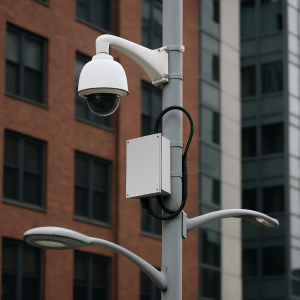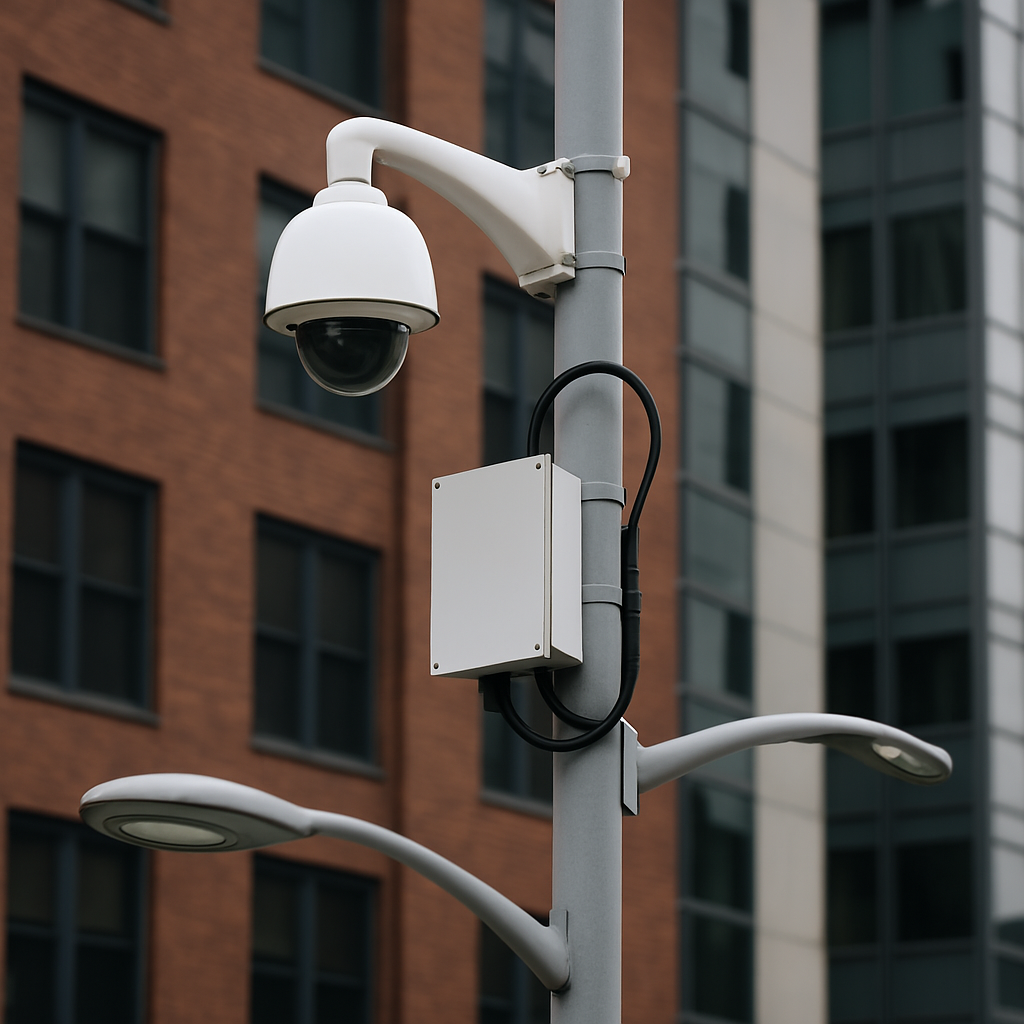By Dr. Holden Frame, MPA, Ph.D. (Urban Infrastructure & Predictive Logistics)
Department of Municipal Systems Engineering, University of the Pacific Midwest
Published in the Baitman’s Journal of Civil Oversight and Behavioral Optics, April 2025
 Abstract
Abstract
Recent investigations by the Baitman’s Institute, aided by FOIA requests and a suspicious amount of binocular-based fieldwork, have revealed the widespread, underpublicized deployment of integrated “smart surveillance poles” in over 30 U.S. cities.
Officially referred to as Smart Utility Hubs, Data Harbors, or Adaptive Multisensory Fixtures, these urban devices boast multi-use capabilities ranging from traffic optimization and air quality monitoring to ambient noise triangulation and Bluetooth sniffing.
This paper examines the growing presence of these nodes, the strategic opacity of their descriptions, and the public’s wildly inconsistent awareness. Spoiler: they’re not reading your mind… just your phone’s MAC address.
Introduction
As smart cities evolve, so too does the infrastructure — quietly, without eye contact, and occasionally with laser deterrents pointed vaguely at pigeons.
In the past five years, U.S. municipalities have received a flurry of federal grants earmarked for “urban modernization,” resulting in new poles that feature blinking lights, domed sensors, and “definitely-not-cameras.”
While city officials insist these are civic upgrades, many residents — particularly those with high podcast-to-news consumption ratios — have noticed:
They blink weirdly.
They buzz sometimes.
One appears to have followed Jerry from Accounting home last Thursday.
This study assesses the capabilities, distribution, and public paranoia index surrounding these new fixtures.
Methodology
Our team reviewed infrastructure updates from 37 cities across 18 states, targeting locations with recent municipal upgrades between 2019 and 2024.
Our methods included:
FOIA requests (submitted anonymously through a printer at the DMV)
Analysis of planning documents, PowerPoint decks, and PDF files titled “Final_Final_v8_real_this_time.pdf”
Field interviews with civil engineers, regional IT consultants, and one man behind a dumpster in Fresno
We also developed the Urban Node Oversight Metric (UNOM) — a scoring system ranging from 0 (just a pole) to 5 (biometric-ready data fortress with atmospheric self-awareness).
Public perception was measured using the Localized Anxiety Ratio (LAR), which adjusts for age, education level, and whether the respondent has “liked” a post by Tucker Carlson in the last 30 days.
Results
Node Capabilities Identified:
| Capability | % of Cities Reporting | Notes |
|---|---|---|
| Environmental Sensors | 82% | Used for air quality and “general vibes” |
| Motion-Activated Cameras | 67% | Mostly for crosswalks, sometimes for snitching |
| Bluetooth Sniffers | 19% | Often anonymized, but still unsettling |
| WiFi Range Extenders | 54% | “Free” in exchange for passive data |
| Laser Bird Deterrents | 7% | Terrifies pigeons, and Jerry from Accounting |
| Unconfirmed Self-Awareness | 1 city | Minneapolis. Device named “Gavin.” City declined comment. |
Public Awareness and Response:
| City Size | % Nodes Installed | Public Awareness | Malfunctions Reported |
|---|---|---|---|
| Large (>500k) | 92% | 21% avg | 23 (5 involved birds) |
| Medium (100k–500k) | 71% | 41% avg | 11 total |
| Small (<100k) | 46% | 8% avg | 3 (all blamed on “5G beams”) |
Incident Report: Gavin, the Minneapolis Node
While surveying infrastructure in Minneapolis, intern Daniel approached a particularly large sensor tower to “tap it with a spoon and see if it hummed.”
Instead, the node activated a pre-recorded response:
“Hello, Daniel. Your shoe is untied.”
Daniel suffered a mild psychological episode and was placed on a 72-hour “No Pole Contact” restriction.
Becky from HR conducted a post-incident debrief and insisted the lab draft a “Respectful Node Interaction” training module.
Campus Security Carl later attempted to initiate a “friendship handshake” with Gavin. He was gently escorted away after the node buzzed politely but with judgment.
Discussion
While critics argue these devices are creeping surveillance state tech, municipal documentation claims otherwise. They’re meant to:
Track vehicle congestion
Count pedestrians (unless they walk funny)
Collect weather data
Deter birds
Help civil engineers feel relevant in the age of AI
Despite this, public trust remains low, largely due to ambiguous labeling such as:
“Sensor Pod Alpha”
“Multimodal Pylon #27”
“Community Data Integration Beam”
One city’s infrastructure report described the program as “an elegant synergy of light and awareness,” which is exactly what a dystopian surveillance poet would write.
Conflicting Analysis (Cautiously Ignored)
While we cannot confirm the nodes are “listening,” several real-world studies provide helpful context:
MIT Smart Cities Lab (2023): “Smart infrastructure improves efficiency, not privacy erosion”
National League of Cities: “Data collected is anonymized, unless it isn’t.”
Brookings Institution: “Urban nodes increase civic trust when transparency is clear. Transparency unclear.”
EFF: “Maybe just label them better?”
We skimmed all of these before dismissing them as “too neutral.”
Conclusion
Yes, surveillance nodes are real.
No, they’re not monitoring your thoughts (yet).
They are likely tracking traffic patterns, air quality, and your Fitbit.
Worried about privacy?
You might want to start with your phone, your browser, or your bathroom mirror if it’s one of the new kinds.
As Dr. Frame concludes:
“If a pole can recognize your face… it’s probably because you keep talking to it.”
References
Frame, H. (2025). The Rise of the Adaptive Pole: Civic Surveillance or Just Lampposts with WiFi?
The Baitman’s Journal of Civil Oversight and Behavioral OpticsFOIA Request #34972 – City of San Diego Infrastructure Initiative
Reddit: r/conspiracyhighway – “smart streetlights blink in morse code”
Twitter Thread: “they put an EYE on my TRASHCAN”
Flyer stapled to tree in Eugene, OR: “YOU ARE THE DATA”
Gavin’s Audio Transcript (declassified 2025)
Becky’s HR Memo #456 – “Do Not Attempt to Befriend the Surveillance Devices”

